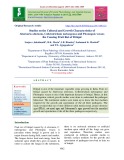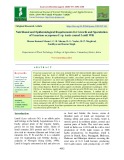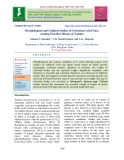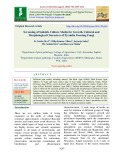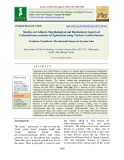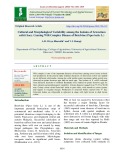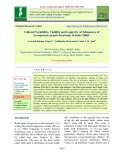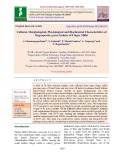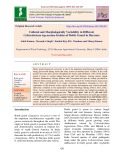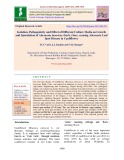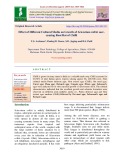
Oat meal agars
-
Brinjal is one of the important vegetable crops growing in India. Fruit rot brinjal caused by Alternaria alternata, Colletotrichum melongenae and Phomopsis vexans is one of the important diseases of brinjal. Hence, in this investigation, critical growth studies were done to understand the pathogen behaviour. The nutritional studies were taken up to know the best medium required for the growth and sporulation of the all three pathogens.
 8p
8p  trinhthamhodang1215
trinhthamhodang1215
 23-09-2020
23-09-2020
 6
6
 1
1
 Download
Download
-
The study was conducted to describe the cultural characteristics such as colour and texture of the leaf blast pathogen Pyricularia oryzae (Cav.) on different solid media viz., potato dextrose agar, potato carrot agar, Kirchoff‟s, medium, Richard‟s medium, Sabourad‟s medium, Takahashii‟s medium, rice leaf extract agar and oat meal agar and liquid media viz., potato dextrose broth, potato carrot broth, Kirchoff‟s broth, Richard‟s broth, Sabourad‟s dextrose broth, Takahashii‟s broth and rice leaf extract broth.
 7p
7p  trinhthamhodang1215
trinhthamhodang1215
 23-09-2020
23-09-2020
 7
7
 1
1
 Download
Download
-
Fusarium oxysporum f. sp. lentis was isolated from wilt infected lentil plant samples were collected from the field of AICRP on MULLaRP at Agriculture Research Station, Ummedganj, (Kota). In epidemiological studies, mycelium growth and sporulation by Fusarium oxysporum f. sp. lentis was significantly influenced with media, temperature and pH level. Maximum colony diameter (90.00 mm) recorded on oat meal agar (Hi-media) medium, which was statistically at par with potato dextrose agar (Hi-media) yielded 88.57 mm colony diameter, Both the media support excellently sporulation by pathogen.
 9p
9p  kethamoi7
kethamoi7
 26-08-2020
26-08-2020
 15
15
 1
1
 Download
Download
-
Morphological and cultural variability of S. rolfsii infecting tomato were studied on different solid and liquid media based on radial growth, topography, sclerotial number, diameter of sclerotia, test weight of sclerotial bodies and dry mycelial weight. Significant variability with reference to mycelial and sclerotial characters was observed on different media. This investigation revealed that the maximum mycelial growth was observed in Potato Dextrose Agar (9 cm) and more test weight (262 mg) of sclerotial bodies was recorded in Sabouraud’s dextrose agar.
 8p
8p  chauchaungayxua6
chauchaungayxua6
 26-06-2020
26-06-2020
 7
7
 2
2
 Download
Download
-
Experiments were conducted to evaluate the effect of some culture media on the vegetative growth of Bipolaris sorokiniana. Five (5) treatment combinations each with three replications were employed. Potato Dextrose Agar (PDA) showed highest radial growth (6.7cm) after 9th day of observation followed by V8 juice agar (6.3cm). Oat Meal Agar showed lowest radial growth (4.6cm) for UBS-1 strain of B. sorokiniana.
 5p
5p  nguathienthan5
nguathienthan5
 04-06-2020
04-06-2020
 11
11
 1
1
 Download
Download
-
The effect of different media (Oat meal agar, Corn meal agar, Czapeck’s Dox agar, Potato dextrose agar, Richard’s synthetic agar and 2% malt extract agar) on light wavelengths (red, yellow, blue, green) and temperatures (10, 15, 20, 25, 30, 35⁰ C) were examined to determine optimal conditions for mycelial growth of Curvularia lunata causing Curvularia leaf spot of maize under in vitro conditions. Amongst media under different temperatures, maximum mycelial growth (88.17 mm) was found in Potato dextrose agar 30⁰ C followed (84.33 mm) by Potato dextrose agar at 25⁰ C.
 4p
4p  trinhthamhodang1213
trinhthamhodang1213
 02-06-2020
02-06-2020
 18
18
 1
1
 Download
Download
-
Different agar media, including natural, Oat Meal Agar (OMA), Malt Extract Agar (MEA), V8 Agar and Leaf extract agar of host plant, semi-synthetic media, Potato Dextrose Agar (PDA), carrot dextrose agar (CaDA) and synthetic media, Czapex Dox Agar (CDA), Richards Synthetic Agar (RSA), Asthana and Hawkers Agar (AHA)) were used to observed the mycelial growth rate, cultural and morphological characters of four fungal isolates after seven days of incubation at 26±1°C.
 8p
8p  caygaocaolon5
caygaocaolon5
 27-05-2020
27-05-2020
 13
13
 1
1
 Download
Download
-
Aglaonema, also called Chinese evergreen, is a popular and low-maintenance houseplant, which not only beautifies our home but also promotes healthier lives by cleaning pollutants from the air. Taking into consideration all these points, the demand for ornamental plants is increasing gradually.
 7p
7p  cothumenhmong5
cothumenhmong5
 17-05-2020
17-05-2020
 5
5
 0
0
 Download
Download
-
Among four isolates of Moesziomyces penicillariae the incitant of pearl millet smut, cultural, morphological and pathogenic variability was studied. The isolates were collected from four different pearl millet growing regions of India. Among the four isolates no variation was observed in size of spore balls but significant variation was observed in their germination percentage. Out of the six different media used, potato dextrose agar medium enriched with 50 g pearl millet grain and 20 g sucrose supported maximum growth of the fungus and least growth was observed in oat meal agar.
 5p
5p  nguaconbaynhay5
nguaconbaynhay5
 11-05-2020
11-05-2020
 10
10
 0
0
 Download
Download
-
Wilt complex is one of the important diseases of betelvine causing severe losses in betel leaf production. In the present study Cultural characters of Sclerotium rolfsii was studied on six different solid media. Among the solid media tested, maximum radial growth was observed on potato dextrose agar and oat meal agar. Ten isolates of S. rolfsii collected from different locations of northern Karnataka were studied on potato dextrose agar for their cultural and morphological variability.
 6p
6p  chauchaungayxua5
chauchaungayxua5
 05-05-2020
05-05-2020
 29
29
 2
2
 Download
Download
-
The teliospores of Sorosporium paspali-thunbergii were observed in spore balls of 17-34 x 42-57 µ. The individual teliospores are globose, sub-globose, angular in shape and yellowish brown to dark brown in colour. The size of teliospore ranged 6-13 x 4-19 µ. Maximum teliospore germination was observed in 2 % glucose solution over 1 % glucose solution and tap water. Maximum radial growth was observed in Potato Dextrose Agar medium followed by Oat Meal Agar medium, Corn Meal Agar medium and Czapek’s dox Agar medium.
 10p
10p  caygaocaolon4
caygaocaolon4
 04-04-2020
04-04-2020
 14
14
 2
2
 Download
Download
-
Rice (Oryza sativa L.) is the world’s most important crop and a primary source of food for more than half of the global population. In India, rice is a staple food for more than 65 per cent population. However, the crop is subjected to attack by many diseases among which rice blast caused by the fungus Pyricularia oryzae is one of the most economically important diseases. The pathogen was isolated from the rice field of Uttar Banga Krishi Viswavidyalaya Farm, purified, and characterized based on morphological and cultural characters. Highest mycelial growth of 28.50 mm and 71.
 9p
9p  caygaocaolon3
caygaocaolon3
 27-02-2020
27-02-2020
 17
17
 1
1
 Download
Download
-
A total of 24 blast infected samples were collected from major finger millet growing areas of Tamil Nadu and also from All India Coordinated Small Millets Improvement Project Centres (ICAR) in India. Pathogenicity test with Magnaporthe grisea isolates showed highly significant differences in virulence on the variety KM 252 in the severity of leaf blast. Among the five different media tested, the Oat Meal Agar medium (OMA) was found to be best for the growth of M. grisea isolates and all the isolates produced white colony colour. The mean mycelial growth was maximum in OMA medium with 80.
 16p
16p  cothumenhmong3
cothumenhmong3
 22-02-2020
22-02-2020
 35
35
 2
2
 Download
Download
-
The study was conducted to describe the growth characteristics of the leaf blast pathogen Pyricularia oryzae isolates on different solid media viz., Host Extract Agar (HEA), Oat Meal Agar (OMA), Potato dextrose agar, Richard’s Agar medium. Among all the solid media the highest mean mycelial growth of the fungus Pyricularia oryzae was recorded on Host Extract Agar (4.08 cm) followed by Oat meal agar (3.83 cm) and least mean mycelial growth of the P. oryzae on Richard’s agar media (3.21).
 9p
9p  chauchaungayxua3
chauchaungayxua3
 07-02-2020
07-02-2020
 12
12
 0
0
 Download
Download
-
Bottle gourd (Lagenaria siceraria) is one of the important cucurbitaceous vegetable crop being grown both during warm and rainy season in northern parts of India. It has wide genetic diversity and is grown throughout the tropics and subtropics of the world. Bottle gourd is prone to various fungal bacterial and viral diseases. Among various fungal diseases Anthracnose, Downy mildew and Cercospora leaf spot are widely prevalent in different bottle gourd growing areas. Anthracnose caused by Colletotrichum lagenarium (Pass.) Ellis. and Halsted is of major economic importance.
 8p
8p  nguathienthan2
nguathienthan2
 26-12-2019
26-12-2019
 34
34
 1
1
 Download
Download
-
The leaf spot disease of Cauliflower (Brassica oleracae L. var. Botrytis) caused by A. brassicae (Berk.) Sacc. was noticed in moderate to severe form on farm of College of Agriculture Engineering and Technology, Dapoli during 2014-2016. The pathogenic fungus was isolated on potato dextrose agar medium from infected leaves of cauliflower. The pathogenicity of the isolated fungus was proved by inoculating healthy seedlings of cauliflower. On the basis of typical symptoms on foliage, microscopic observations and cultural characteristics of the fungus, it was identified as Alternaria spp.
 11p
11p  quenchua2
quenchua2
 15-12-2019
15-12-2019
 13
13
 1
1
 Download
Download
-
Chilli is grown in many states in India as a valuable trade crop. Chilli accounts for 20-30% of total Indian spices exports valuing approx Rs. 400-500 cores. Nine cultural media Potato dextrose agar, Host extract agar (Chilli), Oat meal agar, Carrot agar, Plane agar, Richards agar, Czapeks agar, Elliots agar, Saboroud’s agar were analyzed for in vitro mycelial growth of Sclerotium rolfsii. The cultural characteristics indicated that the excellent growth and sclerotia formation were observed on different semi-synthetic media viz.
 6p
6p  cothumenhmong1
cothumenhmong1
 11-12-2019
11-12-2019
 12
12
 1
1
 Download
Download
-
A study was conducted in vitro to control Colletotrichum dematium causing anthracnose disease of groundnut with Trichoderma harzianum and botanicals. Five botanicals viz., Datura leaf extract, Tulsi leaf extract, Garlic bulb extract, Neem oil and Eucalyptus oil at the rate of 5% were evaluated for their efficacy against the radial colony growth of C. dematium. The complete inhibition was obtained in Eucalyptus oil (100%) followed by T. harzianum (71.01%), datura leaf extract (64.78%), tulsi leaf extract (63.63%), neem oil (49.14%) and garlic bulb extract (43.35%).
 7p
7p  nguaconbaynhay1
nguaconbaynhay1
 04-12-2019
04-12-2019
 14
14
 0
0
 Download
Download
CHỦ ĐỀ BẠN MUỐN TÌM









